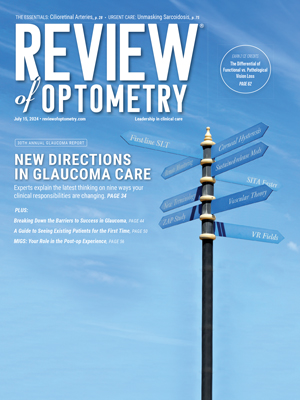For the most part, when a patient presents with symptoms of a dry, scratchy, itchy, burning and gritty feeling, this is a patient suffering from “dry eyes.” Even though itching is a component of the constellation of presenting symptoms, this subcomponent itching is likely an opportunistic expression resulting from ocular surface tear film dysfunction, i.e., dryness. This “packaged” symptomatic itching is best managed by treating the underlying primary dry eye. This is extensively discussed in the dry eye section.
Now, if itching is the predominant symptom, drug selection is dichotomous. If there are minimal associated signs of allergy such as chemosis, conjunctival injection, and/or eyelid edema, then a topical antihistamine/mast cell stabilizer is an excellent clinical approach.
Within this class, there are four drugs:
- azelastine (Optivar, MedPointe)
- epinastine (Elestat, Allergan)
- ketotifen (Zaditor [Novartis], now available generically and OTC)
- olopatadine (Patanol/Pataday, Alcon)
Notwithstanding fine differences, all of these antihistamine subtype 1 receptor blockers nicely suppress ocular itching. All are dosed initially b.i.d. (except Pataday, which is dosed once-daily). We recommend after two weeks at b.i.d., try reducing these to once-daily as “maintenance” therapy. In our experience, once symptomatic itching has been brought under control, it takes less pharmacological effort to maintain that control.
Perhaps the best news for the consumer is the loss of patent protection for Zaditor. Now ketotifen is available generically and OTC. In addition to Zaditor, there are several “brand name” OTC ketotifen preparations, such as Alaway (Bausch & Lomb) and Refresh Eye Itch Relief (Allergan). All come in 5mL bottles (except for Alaway, which comes as a 10mL bottle). Interestingly, our casual observations in a variety of pharmacies reveal that the cost of 10mL Alaway is very near (and occasionally cheaper) than the price of its 5mL counterparts. So, it should be clearly evident that OTC Alaway is the most costeffective way to suppress ocular itch.
The other side of the dichotomous allergy presentation is represented by the patient who presents with predominant itching along with one or more concurrent signs such as conjunctival redness, chemosis and/or eyelid edema. For this subset of patients, a topical corticosteroid such as Alrex, Lotemax or FML ophthalmic suspension would be more appropriate treatment.
The only other decision tree would involve frequency of instillation, which could be q2h for two days, then q.i.d. for one week, followed by b.i.d. for one more week. Once the inflammatory signs are controlled, then switching the patient to an antihistamine/mast cell stabilizer for ongoing symptom control can be considered.
According to a conversation we had with Mark Abelson, M.D., a world renowned ocular allergist at Harvard Medical School, there is little or no clinical use for pure mast cell stabilizing drugs. He says that the antihistamine/mast cell stabilizer drugs more effectively stabilize the mast cell membranes than stand-alone mast cell stabilizers such as pemirolast (Alamast, Vistakon), nedocromil (Alocril, Allergan) or cromolyn sodium (generic). Based on this expert opinion, we now use an antihistamine/mast cell stabilizing drug when protracted mast cell stabilization is indicated.
Remember, allergy is a subset of inflammation. Cold compresses can be helpful in most all ocular surface inflammatory diseases. Infectious processes, on the other hand, are commonly helped by the application of warm soaks.
In summary, if itching is not the primary symptom, be sure to consider dry eyes as the foundational condition and treat accordingly. If itching is primarily expressed, determine if it is an isolated symptom or if it is associated with concurrent inflammatory signs.

